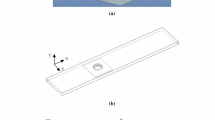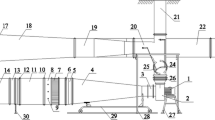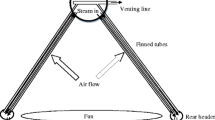Abstract
Acid condensation rate is an important factor denoting the acid corrosion, and the reduction of the acid condensation can significantly relieve the acid corrosive effect on the wall surface and improve the security of the equipments. In this study, the characteristics of both heat transfer and acid condensation of the finned tube in heat exchanger were numerically studied. In the numerical model, we simulated the acid condensation by considering the vapor–liquid equilibrium effect and multi-component diffusion effect. Based on the H-type finned oval tube, we proposed three novel types of fins to both enhance the heat transfer and reduce the acid condensation. The parametric effects of gas temperature, acid vapor concentration, water vapor concentration, and Reynolds number were investigated on different fin structures. The results show that the tube bank with the new structured fins can improve the performance on both heat transfer and acid anti-condensation.











Similar content being viewed by others
References
Moskovits P (1959) Low-temperature boiler corrosion and deposits—a literature review. Ind Eng Chem 51:1305–1312
Webb RL, Wanniarachchi AS (1980) The effect of non-condensible gases in water chiller condensers-literature survey and theoretical predictions. ASHRAE Trans 80:142–159
Osakabe M, Yagi K, Itoh T et al (2003) Condensation heat transfer on tubes in actual flue gas: parametric study for condensation behavior. Heat Transf Asian Res 32:153–166
Abel E (1946) The vapor phase above the system sulfuric acid-water. J Phys Chem 50:260–282
Gmitro JI, Vermeulen T (1964) Vapor–liquid equilibria for aqueous sulfuric acid. AIChE J 10:740–746
Wilson RW (1989) Condensation of sulfuric acid and water mixtures in laminar flow. Dissertation for Doctoral Degree. Lehigh University, Bethlehem
Zhang ZT (1991) Mass transfer processes in flow passages of rotating regenerative air preheaters. Dissertation for Doctoral Degree. Lehigh University, Bethlehem
Volz W (2004) Condensation of water vapour and acid mixtures from exhaust gases. Dissertation for Doctoral Degree. Berlin University, Berlin
Jin BS, Tang ZY, Sun KQ et al (2006) Numerical prediction of deposit rate of condensed sulfuric acid from the flue gas of power plant chimney. Proc CSEE 26:40–44 (in Chinese)
Ahmad M, Berthoud G, Mercier P (2009) General characteristics of two-phase flow distribution in a compact heat exchanger. Int J Heat Mass Transf 52:442–450
Mahmood GI, Ligrani PM (2002) Heat transfer in a dimpled channel: combined influences of aspect ratio, temperature ratio, Reynolds number, and flow structure. Int J Heat Mass Transf 45:2011–2020
Chen J, Müller-Steinhagen H, Duffy GG (2001) Heat transfer enhancement in dimpled tubes. Appl Therm Eng 21:535–547
Ligrani PM, Mahmood GI, Harrison JL et al (2001) Flow structure and local Nusselt number variations in a channel with dimples and protrusions on opposite walls. Int J Heat Mass Transf 44:4413–4425
Chen Y, Fiebig M, Mitra NK (1988) Heat transfer enhancement of a finned oval tube with punched longitudinal vortex generators in-line. Int J Heat Mass Transf 41:4151–4166
Wu JM, Zhang H, Yan CH et al (2012) Experimental study on the performance of a novel fin-tube air heat exchanger with punched longitudinal vortex generator. Energy Convers Manag 57:42–48
Lei YG, He YL, Tian LT et al (2010) Hydrodynamics and heat transfer characteristics of a novel heat exchanger with delta-winglet vortex generators. Chem Eng Sci 65:1551–1562
Leu JS, Wu YH, Jang JY (2004) Heat transfer and fluid flow analysis in plate-fin and tube heat exchangers with a pair of block shape vortex generators. Int J Heat Mass Transf 47:4327–4338
Wang QW, Chen QY, Wang L et al (2007) Experimental study of heat transfer enhancement in narrow rectangular channel with longitudinal vortex generators. Nucl Eng Des 237:686–693
Zhao XB, Tang GH, Ma XW et al (2014) Numerical investigation of heat transfer and erosion characteristics for H-type finned oval tube with longitudinal vortex generators and dimples. Appl Energy 127:93–104
Tian LT, He YL, Tao YB et al (2009) A comparative study on the air-side performance of wavy fin-and-tube heat exchanger with punched delta winglets in staggered and in-line arrangements. Int J Therm Sci 48:1765–1776
Bi C, Tang GH, Tao WQ (2013) Heat transfer enhancement in mini-channel heat sinks with dimples and cylindrical grooves. Appl Therm Eng 55:121–132
Xiao N, Zhang Q, Ligrani PM et al (2009) Thermal performance of dimpled surfaces in laminar flows. Int J Heat Mass Transf 52:2009–2017
Tao WQ (2001) Numerical heat transfer. 2nd ed. Xi’an: Xi’an Jiaotong University Press (in Chinese)
Giauque WF, Hornung EW, Kunzler JE et al (1960) The thermodynamic properties of aqueous sulfuric acid solutions and hydrates from 15 to 300 K. JACS 82:62–67
Copeman TW, Stein FP (1982) On the derivation of solution thermodynamics for reactive components. Fluid Phase Equilib 9:149–165
Gee DL, Webb RL (1980) Forced convection heat transfer in helically rib-roughened tubes. Int J Heat Mass Transf 23:1127–1136
Liu YZ, Yuan YC, Xu SY et al (2004) Experimental study on the characteristics of heat transfer and flow resistance for H-type finned tube banks. J Univ Shanghai Sci Technol 26:457–460 (in Chinese)
Acknowledgments
This work was supported by the National Basic Research Program of China (2011CB710702) and the National Natural Science Foundation of China (51222604).
Author information
Authors and Affiliations
Corresponding author
Additional information
SPECIAL TOPIC: Deep Utilization of Boiler Low-Temperature Flue Gas
Appendix
Appendix
- A :
-
Area (m2)
- a i , b i , c i :
-
Ideal-gas heat capacity coefficients
- \( \bar{a}_{i} \) :
-
Activity
- \( C_{{1\upvarepsilon}} ,C_{{2\upvarepsilon}} \) :
-
Turbulence model constants
- c p :
-
Specific heat (J kg−1 K−1)
- \( \bar{C}_{{{\text{p}}i}}^{\text{l}} \) :
-
Partial-molar heat capacity (J mol−1 K−1)
- D i,m :
-
Effective diffusion coefficient for species i (m2 s−1)
- D ij :
-
Binary diffusion coefficient (m2 s−1)
- Eu :
-
Euler number
- f :
-
Friction factor
- G k :
-
Generation of turbulence kinetic energy
- h :
-
Heat transfer coefficient (W m−2 K−1)
- ΔH v i :
-
Heat of vaporization (J mol−1)
- k :
-
Turbulent kinetic energy (m2 s−2)
- K 0, K 1 :
-
Equilibrium constants
- \( \bar{L}_{i}^{\text{l}} \) :
-
Partial-molar enthalpy (J mol−1)
- m i :
-
Mass condensation rate of i component (kg m−2 s−1)
- M :
-
Molar mass (kg mol−1)
- N :
-
Number of tube bank
- Nu :
-
Average Nusselt number
- p i :
-
Monomer partial pressure (Pa)
- p io :
-
Apparent partial pressure (Pa)
- P :
-
Pressure (Pa)
- PEC:
-
Evaluation parameter of a heat transfer unit
- Δp :
-
Pressure drop (Pa)
- Pr :
-
Prandtl number
- R a :
-
Sulfuric acid condensation rate (mol m−2 s−1)
- Re :
-
Reynolds number
- R w :
-
Water condensation rate (mol m−2 s−1)
- r i :
-
Latent heat of i component (J kg−1)
- Sc t :
-
Turbulent Schmidt number
- S e :
-
Energy source term (J m−3 s−1)
- ΔS v i :
-
Entropy of vaporization (J mol−1 K−1)
- S m :
-
Species source term (kg m−3 s−1)
- T :
-
Temperature (K)
- U :
-
Velocity vector (m s−1)
- V :
-
Grid volume (m3)
- x a :
-
Sulfuric acid vapor mole fraction in gas phase
- x w :
-
Water vapor mole fraction in gas phase
- y i :
-
Mole fraction of i component in solution
- Y i :
-
Mass fraction of i component
- ϕ io :
-
Apparent fugacity coefficient
- λ :
-
Thermal conductivity (W m−1 K−1)
- υ :
-
Kinematic viscosity (m2 s−1)
- ρ :
-
Density (kg m−3)
- α i :
-
Partial-molar heat capacity coefficient (J mol−1)
- ɛ :
-
Turbulent energy dissipation rate (m2 s−3)
- η t :
-
Turbulent viscosity (kg m−1 s−1)
- \( \alpha_{k} ,\alpha_{\varepsilon} \) :
-
Inverse effective Prandtl numbers for k and ɛ
- a:
-
Sulfuric acid
- g:
-
Flue gas
- in:
-
Inlet
- out:
-
Outlet
- w:
-
Wall or water
About this article
Cite this article
Wang, YC., Tang, GH. Acid condensation and heat transfer characteristics on H-type fin surface with bleeding dimples and longitudinal vortex generators. Chin. Sci. Bull. 59, 4405–4417 (2014). https://doi.org/10.1007/s11434-014-0564-3
Received:
Accepted:
Published:
Issue Date:
DOI: https://doi.org/10.1007/s11434-014-0564-3




